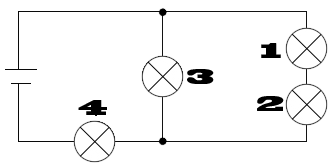Removing bulbs
This task is about electric circuits.
Why is it important to know this? Every day we use electricity for such things as heating, lighting and cooking. Knowing what may stop an electrical circuit working is useful for working out why an appliance is not working, or to build electric circuits ourselves.

A box has four bulbs screwed into sockets on its top. A circuit diagram of this is drawn above.

